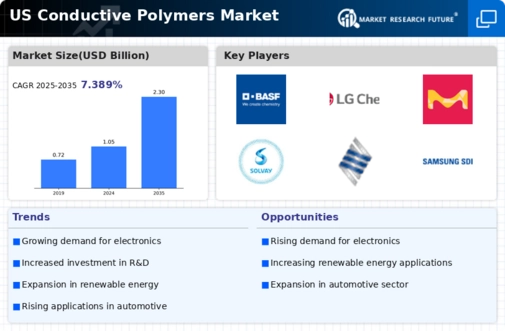The conductive polymers market is characterized by a dynamic competitive landscape, driven by innovation, sustainability, and technological advancements. Key players such as DuPont (US), BASF (US), and 3M (US) are actively shaping the market through strategic initiatives. DuPont (US) focuses on enhancing its product portfolio with advanced materials that cater to the growing demand for lightweight and flexible electronics. Meanwhile, BASF (US) emphasizes sustainability in its operations, aiming to reduce carbon emissions and enhance the recyclability of its products. 3M (US) leverages its extensive research capabilities to develop innovative conductive polymer solutions, positioning itself as a leader in the market. Collectively, these strategies foster a competitive environment that prioritizes technological advancement and environmental responsibility.
In terms of business tactics, companies are increasingly localizing manufacturing to enhance supply chain efficiency and reduce lead times. The market structure appears moderately fragmented, with several key players exerting influence over various segments. This fragmentation allows for niche players to thrive, while larger corporations leverage their resources to optimize operations and expand their market reach. The collective influence of these key players shapes the competitive dynamics, as they strive to differentiate themselves through innovation and customer-centric solutions.
In November 2025, DuPont (US) announced a partnership with a leading tech firm to develop next-generation conductive polymers for wearable technology. This collaboration is expected to enhance DuPont's capabilities in the rapidly growing wearable market, allowing the company to tap into new revenue streams and strengthen its market position. The strategic importance of this partnership lies in its potential to accelerate product development and meet the increasing consumer demand for advanced wearable devices.
In October 2025, BASF (US) launched a new line of eco-friendly conductive polymers designed for use in automotive applications. This initiative aligns with the company's commitment to sustainability and positions BASF as a frontrunner in providing environmentally responsible solutions. The introduction of these products is likely to attract automotive manufacturers seeking to reduce their environmental footprint while maintaining high-performance standards.
In September 2025, 3M (US) unveiled a breakthrough in conductive polymer technology that significantly enhances the conductivity of its materials. This innovation is poised to revolutionize applications in electronics and energy storage, providing 3M with a competitive edge in the market. The strategic importance of this development lies in its potential to address the growing demand for efficient energy solutions, thereby solidifying 3M's leadership in the conductive polymers sector.
As of December 2025, current trends in the conductive polymers market indicate a strong emphasis on digitalization, sustainability, and the integration of AI technologies. Strategic alliances are increasingly shaping the competitive landscape, enabling companies to pool resources and expertise to drive innovation. The shift from price-based competition to a focus on technological advancement and supply chain reliability is evident, suggesting that future competitive differentiation will hinge on the ability to innovate and respond to evolving market demands.


















Leave a Comment